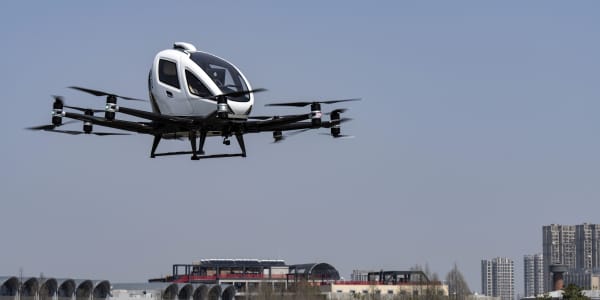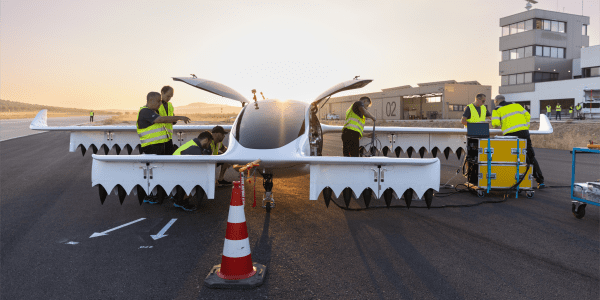Concept cars have been a staple of the automotive landscape for decades. Manufacturers use them to pique consumers' interest, but also to showcase new technology and features they hope to unveil in later production cars.
That was certainly the case with the 1938 Buick Y-Job, one of the world's first concepts. The Y-Job employed a vertical waterfall grill that would become a signature of the Buick brand for decades and more importantly, helped introduce features — like electric windows, the powered convertible top and recessed door handles — that would eventually become common on mainstream production cars.
Innovation didn't stop in the late 1930s. Both new and established manufacturers present futuristic concept cars regularly. Some of these will be on display later this month at the Los Angeles Auto Show, the last big international vehicle expo of 2018.
We looked at some of the most interesting concept vehicles today and the technology and features that help make them stand out — or fly, literally.
Buick Enspire
While Elon Musk's Tesla electric crossover Model Y may grab the most headlines, General Motors' Buick brand unveiled its Enspire crossover at this year's Beijing Auto Show. The company, which is popular in China, has designed a 550-horsepower electric motor that will let the Enspire reach 60 mph in just 4 seconds, faster than any previous Buick. Range for the electric car is an impressive 370 miles. Though tall and fairly rectangular like most crossovers and SUVs, the concept is nonetheless extremely elegant, and it gets more interesting on the inside.
Features include an augmented reality display for the windshield that can show road information and navigation routes, and seats with shock absorbers built into the frame. It also has taillights that indicate braking intensity to other drivers.
Buick has not officially announced whether the Enspire will head to production, but a spokesman noted that the company has an 80-year history of drawing inspiration from concepts since the Y-Job's debut. "Concepts serve as guiding lights to where our brand is going," he said.
Genesis Essentia
This four-passenger grand tourer made the auto show rounds this year. It has fingerprint controls and biometric facial recognition sensors to open its butterfly doors (no more worries about losing your keys). Like many concepts these days, the Essentia is battery-powered. Where it differs is in its sleek proportions. While many new concept and production cars are tall and boxy, the Essentia features an extremely low, transparent hood that flows into the windshield, and its overall height is only 50 inches.
As it represents Hyundai Motors' luxury brand, the Essentia also boasts advanced computational power and the ability to communicate with infrastructure and other vehicles to avoid accidents and traffic jams. By integrating with smart devices, the Essentia can adjust HVAC settings for its owner's return home, turn on lights and help allow for package deliveries.
Honda Urban EV
This tiny but pugnacious-looking concept is packed with clever features, like rear seat belts that pull from the center to aid entry and exit, screens in the upper door panels that display images from side-mounted cameras, and a digital assistant that can interpret the emotional state of the driver. The space in the front where a grill would go on traditional internal-combustion vehicles instead has a screen that can display messages to pedestrians and other drivers. Honda plans to sell a production version of the Urban in Europe early next year but has not announced plans for North American sales.
Italdesign Airbus Pop.Up Next
"The Jetsons" envisioned a future with flying cars. This European concept takes it even further, with a modular design that can both fly and drive.
Volkswagen Group's Italdesign teamed with the aerospace company Airbus to debut the Pop.Up flying-car concept at the 2017 Geneva Motor Show. For 2018 the firms refined the design to be lighter and more aerodynamic and renamed it the Pop.Up Next. This enhanced concept features a small two-person pod that can be fitted to either a four-wheeled chassis for street use or a four-propeller flying module for short-range flights. The concept is battery powered and completely autonomous on both land or air — passengers merely tell it where they need to go, then sit back and enjoy the ride. Though not production-ready, the Pop.Up Next was displayed in Geneva earlier this year under VW's Audi brand.
Volvo 360c
Volvo's 360c is a fairly radical design. It looks forward to a future where people — freed from having to drive by autonomous technology — use their vehicles for more than just transportation. The 360c's interior can be configured with a desk for working or a table over which passengers can eat, chat or otherwise interact face-to-face. There's even a setup with flat bedding for sleeping. Volvo's commentary about the concept positions it as a convenient, efficient and painless alternative to short commuter flights. The 360c also makes use of lights and sounds to signal to pedestrians and other vehicles what it will do next. This communications system is aimed to increase safety, a hallmark of the brand.
Nissan Xmotion
Introduced at the Detroit Auto Show earlier this year, the Xmotion ("crossmotion") is designed to bridge old and new. This angular family-size vehicle comes with a whopping seven digital touchscreens and an in-car digital assistant resembling a koi fish — the colored varieties of carp often seen in garden ponds — that swims between them. Displays and the vehicle's infotainment can be controlled with hand gestures and eye movements, and fingerprint authentication is used to start it up.
In addition to its prodigious employment of screens, the Nissan also makes heavy use of matte-finished wood throughout the interior. This tempers the impact of all the technology, and makes it makes the interior warmer and more inviting. You'll find wood on and under the dash, along the seats and covering a large beam dividing the left and right halves of the vehicle. Including so much old-school joinery with the otherwise modern interior gives it a unique look among SUVs. Nissan has indicated the Xmotion signals the design direction the company will take with production vehicles.
Hyundai Le Fil Rouge
The South Korean brand once known for economy cars has steadily moved upmarket — not just with its Genesis luxury brand but also with its more mainstream Hyundai brand — and the sensuous Le Fil Rouge concept shows that trend continuing. This sleek four-door concept was created under the direction of Luc Donckerwolke and SangYup Lee, who'd previously designed for Bentley and Lamborghini. It features a panoramic display across the entire dash — a first for the brand — as well as two smaller screens for rear seat passengers. Heavy use of curved wood adds warmth to the interior and contrasts with the high-tech touches.
Hyundai notes that the concept's flowing design language will eventually be seen throughout its lineup, which explains the name (le fil rouge translates to "the common thread" in French).
Toyota FT-4X
This tough-looking little concept is less concerned with buzzy high tech than functional low tech, which may be more useful to many outdoorsy owners.
It came out of Toyota's American Calty Design Research center last year and functions as a sort of toolbox for recreational pursuits. The rear cargo area is flat and has an extra storage area hidden underneath, so nothing especially weird there. But many parts of the FT-4X serve more than one function. For instance, the rear doors feature heated and cooled boxes that can be used to keep food chilled and fresh on one side, while warming up winter gear on the other. The crossover's inside lighting is removable for use as a flashlight and each rear door handle can be pulled out and used as a water bottle. The front center armrest is actually a small sleeping bag, and the multimedia audio system in the dash can be taken out and used as a boom box.
A Toyota spokeswoman said the FT-4X is not slated for production. This might be a relief for tiny house manufacturers, since a dedicated owner could probably live in this concept, were they sufficiently hard-core.





